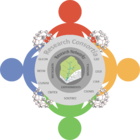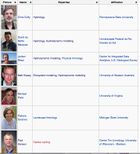Main Page
Contents
What is Organic Data Science?
We are investigating Organic Data Science, a new approach aimed to allow scientists to formulate and resolve science processes through an open framework that facilitates ad-hoc participation and entice collaborators based on attractive science goals. Organic Data Science]] allows scientists to formulate and resolve science processes through an open framework that facilitates ad-hoc participation and entice collaborators based on attractive science goals.
Accomplishing this requires three elements:
- a science approach to tackle the problem of the age of water,
- a technical substrate that facilitates transdisciplinary collaborations, and
- a social approach to engage the community.
Read more about Organic Data Science.
Our Science Goal: The Age of Water and Carbon
This study focuses on long-standing problems of coupled water and carbon budgets through development of a new scientific paradigm, The Age of Water and Carbon, that melds theory and practice from limnology and hydrology within the new collaborative paradigm of Organic Data Science. We are integrating analytical frameworks from two communities – hydrology and isotope modeling in Critical Zone Observatories (CZOs) and hydrodynamic water quality modeling from the Global Lake Ecological Observatory Network (GLEON) – to quantify water and material fluxes from two research sites, the Shales Hills CZO and the GLEON member site, North Temperate Lakes LTER. This foundation will serve as a nexus for participation by multiple communities and will seed the growth of additional science through shared ideas, knowledge, and data.
Ongoing Science Activities
Our project goal is to predict pathways and age of water and carbon isotopes for lake-catchment systems. To that end, we are working with the community in several major activities:
- Develop a computational model for water and carbon isotopes in lake-catchment systems
- Select core lake and catchment models
- Implement the catchment model for North Temperate Lakes
- Implement the lake model for North Temperate Lakes
- Couple the lake and catchment models
Technical and Social Aspects of Organic Data Science
We are pursuing a social computing approach that takes into account human aspects such as incentives and participation, while providing the fabric for representing and coordinating tasks involved in accomplishing science goals. Our approach will openly expose science tasks, facilitating inspection and engagement of new potential contributors. The collaboration will grow in an organic way, drawing in people and other contributions from existing data providers and cyberinfrastruture resources.
Read more about our work on designing the technical and social aspects of our organic data science framework.
Contributing to Organic Data Science
There is a growing set of contributors to the project.
We have Special Information for Newcomers to catch up with what we have been doing so far and our plans for the future.
We are using a semantic wiki framework with significant extensions to structure collaboration processes. Read more about how this framework works and how to participate and contribute.
Get an account, and learn how to use this wiki.
Acknowledgments
This work is supported by the National Science Foundation through the INSPIRE program with grant number IIS-1344272.


